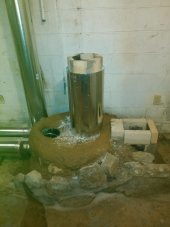posted 8 years ago
Good observations on your fuel Bruce. I think Duane gave good info. As he said, there is likely a sweet spot that you will find which generates the optimum burn temperatures.
It should be noted that fuel is often split to facilitate drying, as dry wood burns hotter for a number of reasons.
Assuming that your wood of all different sizes in an experiment were equally dry, then the fire triangle comes into play as another key factor.
The triangle has fuel, oxygen, and temperature as it's components. When all of these meet the minimum requirements, fire occurs.
On top of this, the fuel type, the oxygen levels, and the adequate temperature for combustion also all have variables; red cedar for instance burns more rapidly and hotter in the short term than many other woods due to it's airy consistency and highly flammable oils, but it will not produce a long lasting burn that say an equal volume of oak does. On top of this, as Duane mentioned, the volume of a stick when starting a fire is much different than when a fire is already rocking, and fuel types (species) would make a difference here as well. Larger cedar chunks will last longer, and produce high heat, whereas smaller chunks will produce a short burst of heat, and that heat might not be quite as substantial as that produced by somewhat larger fuel; it burns too rapidly and does not have as much opportunity to radiate. Different fuel species will likely have very different sweet spots in this regard, but generally, in the bush I go from match stick size to finger sized to thumb sized to wrist sized, and once you get to forearm sized you can burn anything, but if you try to go from matchstick sized to forearm size you are going to have issues. The fire just isn't hot enough, or have enough lasting power to ignite the larger wood.
Where the oxygen is delivered to the fire and in what volume makes a large difference on the effectiveness of this component as well. People split the large wood block to expose more of the cellular resins to ignition temperature so that they will vaporize and ignite, but this does the extra purposes of giving it oxygen during the firing and drying it beforehand. As in most Rocket stoves, and RMH's in particular, keeping the main combustion area at a certain optimum temperature is a design feature, usually done by insulating the combustion zones. I know in your case, with steel and air cooling you are doing something quite different. I'm just stating that all of these factors in the triangle are not only necessary, but they are in a flux depending on the components. So in the case of your pallet wood, there is a sweet spot where splitting down to a point is essential, and a point where you are going to have diminishing returns, based on the density of the fuel, it's relative combustability at your ignition point, the heat that is potentially generated at that location and throughout the combustion zone, and how the oxygen is supplied to it in the initiating burn location as well as throughout the gas burning area, and all of that combined with the draw that you are receiving that is pulling the air/gasses through the rest of the system.
Lots of things to experiment with. Again, good observations, ..........and keep tinkering!
"Never doubt that a small group of thoughtful, committed citizens can change the world; indeed, it's the only thing that ever has."-Margaret Mead "The only thing worse than being blind, is having sight but no vision."-Helen Keller












